by Heather Plett | Sep 2, 2014 | growth, journey
There’s something about September – the way it hovers in between seasons, reminding us of what we’re leaving and what is yet to come.
 I always feel a mix of emotions at this time of year.
I always feel a mix of emotions at this time of year.
I feel the melancholy of summer ending. I feel the sadness over school starting again (mixed with a little joy that I’ll have a quiet house again). I feel the dread of winter just around the corner.
I also feel the delight over the weather shifting and the vibrant colours showing up on the landscape.
When I’m honest with myself, I have to admit that I love September. It’s probably one of my favourite months. I don’t love the heat and I don’t love the cold and September is usually just right.
And yet… I don’t always let myself love it. I get caught up in the rush of trying to get the girls back to school and I get mired in that sinking feeling of winter coming and I forget to pause long enough to really appreciate the way the weather has shifted into a more gentle warmth with cooling evenings and the way the trees are adorning themselves in orange and yellow and red.
I love long walks in crunching leaves. I love campfires on cool evenings. I love the quality of light at this time of year. I love slipping on a sweater when the weather begins to cool.
Despite the melancholy it brings, I truly love September.
But… there’s something else about this time of year that I don’t love.
It’s the season when death feels close at hand.
There’s a pattern in my family. Most of the births happen in the first half of the year, and most of the deaths happen in the second. My dad, my mom, my son, my father-in-law, and most of my grandparents – they all died between August and November.
And so this time of year comes with reminders of all that I’ve lost.
And this time, September brings with it the possibility of another loss. My oldest brother, who’s been battling cancer for over a year, with multiple surgeries and lots of chemo, has been told the cancer is growing again and there may not be anything they can do. He was told he may have only months to live. (And then, a few days later, he was told they’ll probably make one last ditch effort to save him through surgery.)
When I let myself think of the possibility of losing him, desperation closes my throat and it’s suddenly painful to breathe and impossible to swallow. NO! Death can’t take another member of my family! It’s too soon! I NEED him! It’s not even two years since Mom left us. Please God NO! He’s my big brother. He’s always been a rock in the storm, a solid place to land – as dependable as the earth beneath my feet. I need something dependable in my life. He JUST. CAN’T. GO.
And then I realize… it’s just like September. If I focus only on the fact that I might lose my brother, I’ll forget to live in the now. I’ll forget to see the beauty. I’ll forget to laugh at the jokes he sends, forget to appreciate all that he’s been in my life, forget to recognize what a gift it’s been to grow up in a family so full of love, faith, humour, and wisdom.
If I rush through September, lamenting the summer that’s been and dreading the winter that’s coming, I’ll miss this month that I love so much. If I rush through my life, feeling sorry for myself over all that I’ve lost and dreading the losses yet to come, I’ll miss everything that makes my life so good and beautiful.
I don’t want to miss September. I want to be present for what’s here. Now.
Winter might be hard and long, but right now is beautiful. Right now the sun is painting the tips of the trees with gold. Right now the birds are still singing, the butterflies are still dancing, and the sun is still warming my skin. Right now I have friends who invite me to campfires in teepees and other friends who don’t mind walking through the English gardens in the rain with me. Right now I have daughters who make me laugh. Right now I have a brother walking a courageous path through cancer, who’s crazy in love with his family, and I get to be part of that big love.
Right now is all I need.
If you want to be more present for what’s here right now, you might like Fall Reflections: A Mindfulness Journal.
by Heather Plett | Aug 18, 2014 | connection, Creativity, journey, writing
In honour of the release of Fall Reflections: A mindfulness journal, I’m sharing these ten tips. For some who are just beginning a journal writing practice, they may offer a place to start. For others they may offer enhancement to an ongoing practice.
1. Start with the facts, then move to the feelings. Begin by describing the details of your day. What did you do, who did you see? As you write, consider how you responded emotionally to whatever happened.
2. Try a stream-of-consciousness style of writing. Just write the next thing that comes to mind. If you’re writing about the conversation you had with your mom, for example, a question might suddenly come to mind about something your mom said. Write it down. Don’t censor. Just write.
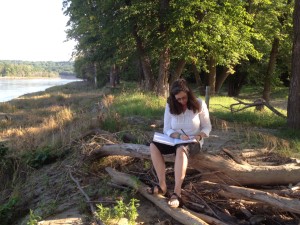 3. Keep it simple and don’t edit. Your journal is not a place to prove you should be the next poet laureate. It’s about the process, not the product. Use simple language, and write what comes to mind rather than over-thinking what words to use.
3. Keep it simple and don’t edit. Your journal is not a place to prove you should be the next poet laureate. It’s about the process, not the product. Use simple language, and write what comes to mind rather than over-thinking what words to use.
4. Keep the “shoulds” out of it. Your journal is a place to be honest with yourself, not a place to try to reform yourself into what you think you should be. Simply write how you feel and what you think rather than filtering it with what you think you SHOULD think or feel. There’s enough of that self-filtering when you talk to others and it doesn’t belong in a journal that’s meant for your eyes only.
5. When you’re trying to work through internal conflict, try writing a dialogue with yourself. If, for example, there’s part of you that wants to go on a trip and another part of you that thinks it’s a bad idea, write as though those are two separate people having a conversation back and forth.
6. If the blank page scares you, use journal prompts to help you get started. Fall Reflections or Summer Lovin’ might be a good place to start. Or you could choose to start each day’s entry with the same simple journal prompt such as “My wish for today is…” or “Five words to describe this day are…” or “The things I want to remember about this day are…”
7. Try keeping a list every day. It could be a list of ten things you’re grateful for each day. Or five ways that you were kind to others. Or three ways that you stood up for yourself. Consider what would help you in your personal growth (gratitude, confidence, courage) and create a list prompt around that theme.
8. Find a routine that works for you. Some people write morning pages (filling 3 pages with stream-of-consciousness) every day. Others set aside half an hour each day for journal-writing. Sometimes I suggest to my coaching clients that they simply sit with a pen in their hand for ten minutes each day and see what emerges. (If it’s just doodling some days, that’s perfectly fine!) You have to find what works best for you, or you won’t sustain it.
9. Find the right pen and journal combination that works for you. I love sturdy, attractive journals, and so I give myself permission to splurge a little each time I buy a new one. I also love to write in colour (and change colours on a whim) so I write with fine tip Sharpie markers. You, on the other hand, may love expensive pens but are content with the kind of notebook you used in elementary school. Experiment until you find what makes you happy.
10. Take your journal with you. You never know when you’ll want to write things down, so it’s a good idea to carry it with you on the bus, to the coffee shop, on a trip – wherever you go. If your journal is too big, consider having a smaller secondary notebook in your purse or backpack.
Finally, just be yourself and write what you want to write. There is no wrong way to do this! Just start wherever you are, write in your very own style, and don’t do it to please anyone else but yourself.
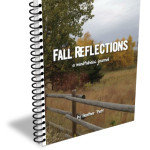 p.s. For only $10, you can download Fall Reflections and you’ll have 60 journal prompts to get you started. If you want to go even deeper with your writing, my next Openhearted Writing Circle will be October 4, 2014.
p.s. For only $10, you can download Fall Reflections and you’ll have 60 journal prompts to get you started. If you want to go even deeper with your writing, my next Openhearted Writing Circle will be October 4, 2014.
by Heather Plett | Aug 26, 2013 | Beauty, calling, Intuition, journey, Labyrinth
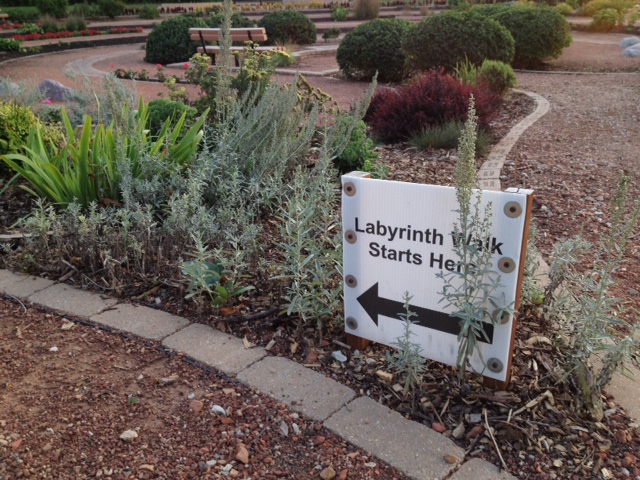 When you stand at the very centre of the Carol Shield’s labyrinth, as I did yesterday evening, and speak out to the edges, you will hear your own voice echoed ever so slightly back to you. You have to listen very carefully to hear it and you have to be standing in exactly the right spot or the echo evades you.
When you stand at the very centre of the Carol Shield’s labyrinth, as I did yesterday evening, and speak out to the edges, you will hear your own voice echoed ever so slightly back to you. You have to listen very carefully to hear it and you have to be standing in exactly the right spot or the echo evades you.
In labyrinthian journeys, the centre is known as the place where you open yourself to receiving from Spirit, after walking in and releasing what was previously getting in the way.
Which begs the question… what am I meant to receive from the echo of my own voice? What wisdom is already hidden in me that I might not yet be aware of?
Yesterday in church the pastor spoke about giftedness – how we need only be faithful with our gifts in order for them to multiply. At the centre of the labyrinth, I thought about that in relation to my voice. It’s a gift that already exists, coming out of a wisdom that God has already planted within me, and I don’t need to keep looking elsewhere for my source of inspiration.
Faithfulness to our gifts means that we must exercise them, train them, and grow them. Practice and study are both very important, but what’s also important is a deep level of trust in the gift itself.
In our eagerness to perfect the gift, and our insecurity about using it before it is sufficiently polished, we forget about the ancient wisdom already there. We forget that the unpolished gift already has beauty.
When I was a child, I had a growing realization that I had a unique ability to see things – to really see them in a deeper way than most people did. When I would try to explain things that I’d seen to other people, I knew by their lack of understanding that they’d never witnessed them in the same way that I did.
These were fairly ordinary things, but for me they had an aura of magic. For example, I was always captivated by the image of deer leaping over fences. That sight would freeze me in my tracks and I was stand in awe at the magic I had just witnessed. When I would try to explain how that sight impacted me, people would usually look at me with a puzzled look and I knew that they’d only ever seen deer leaping over fences as ordinary and not transcendent.
I stopped talking about things that seemed mystical to me. It made me feel too much like an oddball. Now, years later, I recognize that ability to see things as a part of the ancient wisdom buried in me. I am a meaning-maker, a storycatcher, a seer… perhaps even a mystic. I see metaphor and meaning in things that pass many people by. I receive messages from deer or trees or sunsets and I walk away changed. It’s still not always easy to talk about (as I mentioned in my last post), but I am growing in my ability to trust it.
In The Naked Now: Learning to See as the Mystics See, Richard Rohr talks about the three ways to see a sunset…
One man saw the immense physical beauty and enjoyed the event in itself. This man was the “sensate” type who, like 80 percent of the world, deals with what he can see, feel, touch, move, and fix. This was enough reality for him, for he had little interest in larger ideas, intuitions, or the grand scheme of things. He saw with his first eye, which was good.
A second man saw the sunset. He enjoyed all the beauty that the first man did. Like all lovers of coherent thought, technology, and science, he also enjoyed his power to make sense of the universe and explain what he discovered. He thought about the cyclical rotations of planets and stars. Through imagination, intuition, and reason, he saw with his second eye, which was even better.
The third man saw the sunset, knowing and enjoying all that the first and the second men did. But in his ability to progress from seeing to explaining to “tasting,” he also remained in awe before an underlying mystery, coherence, and spaciousness that connected him with everything else. He used his third eye, which is the full goal of all seeing and all knowing. This was the best.
The third man, who sees with his third eye, is a mystic. As soon as I read Rohr’s description of what it means to be a mystic, I knew that this had something to do with the way that I’d always seen the world. The seeds of mysticism were already there when I stood in awe of deer leaping over fences.
I have read a thousand books, taken a thousand classes, and yet none of them can teach me to access the ancient wisdom – the wisdom of the seer – that is already within me. None of them can point to the gift that is meant for me to share. For that I must quiet all of the external voices, remove myself from the noise of my life and walk a labyrinth or wander the woods. That is when my own voice is echoed back at me and I know that I already have what I need.
What is the ancient wisdom buried in you? It may be body wisdom, heart wisdom, or head wisdom. It may be the ability to see justice, create order, experience beauty, shape stories, make people laugh, or offer compassion. What did you already know as a child, but might have been afraid to speak of or do or be because it made you seem like an oddball? What do you now need to do to create space for that wisdom to emerge?
To start with, find a quiet place where your wisdom can echo back to you through the silence. Walk away from the noise of other people’s voices and expectations and stand in silence with your God. In that quiet place, let your gift emerge from its hiding place, let it fill your heart with knowing, and give yourself permission to trust it. Then, by all means, practice, train, and polish it, but don’t forget to use it in the meantime. It already has value.
The gift is yours – be faithful in using it and it will multiply.
by Heather Plett | Jun 17, 2013 | dreaming, journey, Uncategorized
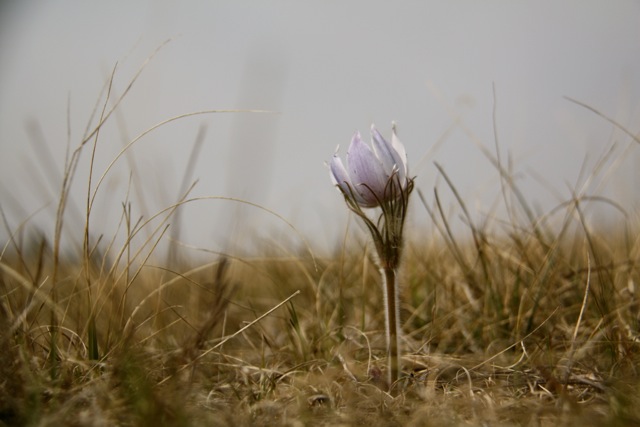
I have a love/hate relationship with the word “intention”. I feel similarly about the word “manifest”. In the coach-y personal development world that some of my work fits into, people like to say things like “you have to set your intention in order to manifest your dreams”.
That kind of statement always makes me cringe a little.
The cringe comes from years of experience that has taught me that, despite what we want to believe, the universe is not an ATM machine that will spit out crisp, beautiful, unwrinkled dreams if only we punch in the right code. There is no simple magic – unless you’ve put something into the account, the ATM machine has nothing to pump out.
It also comes from the part of me that is fed up with the me, me, me culture we live in that I wrote about in my last post. We can’t expect our dreams to come true unless we are willing to invest in the collective dreams of our community.
In addition to those reservations, I also continue to believe that there is a God who orders the universe, and most of the time, we don’t get to see the big picture the way God does. There are times when we’re going to have to live through devastating disappointment – when our dreams come crashing at our feet – and we won’t understand the value in all of that heartache until we’re far into the future looking back in the rearview mirror.
All of that being said, I haven’t entirely given up on the word “intention”.
About ten years ago, I read a book about naming your personal mission and setting the direction you want to head in your life. At that time, I was employed in a government job that made me miserable and I was looking for some path out of it and into something more in line with who I am and what I’m passionate about. In the book was the suggestion that you should write out a “day in the life” journal page as though you are writing it five years in the future. The author of the book claimed that nearly everyone she knew who’d done that ended up almost exactly where they wanted to be.
I wrote my journal page, and you know what? The things I wrote about doing are almost exactly the things I spend my time doing now – teaching, hosting workshops, and writing. It took a few more than 5 years, but I landed where I’d hoped to land. The only part that didn’t come true was my wish for a house with a front porch and a porch swing. (I’m still holding out hope.)
There is definitely something about naming and owning your desires that helps you move in their direction.
So, despite my reservations, I still believe in intention-setting. I just believe in a little realism thrown in for good measure.
Here are a few of my thoughts on intention-setting:
- Your longings and passion are there for a reason. God gave you a desire to do the things that you love to do and it’s not selfish to want to do them. It’s only selfish if you keep them to yourself or if you do destructive things with them. Explore the deep longings in your heart and set an intention based on who you truly are and what you have to offer the world.
- Be prepared for a lot of detours on the path. Just because you set an intention doesn’t mean you’re going to get a straight path to its realization. Like I often tell clients, your journey is like a labyrinth. You always know that the centre is your destination, but sometimes you turn the corner and find yourself further from the destination than you were before. A few years after my journal-writing, for example, I found myself out of government and in a non-profit job that I loved, but that wasn’t quite where I expected to be. I learned a lot from that job though, so I have no regrets. Keep following the path and one day you’ll reach centre, though centre might not always look like you expected it to look.
- Hold your intentions lightly. Sometimes, on the path to making your dream come true, you’ll realize that there’s actually a bigger and better dream in store for you, or that you were dreaming the wrong dream, or that your dream is rather selfish. The things I teach in many of my workshops now are actually even more close to my heart than what I wrote about in the journal because I’ve done a whole lot of learning in the intervening years. Much of that learning came in the form of really tough lessons and disappointments. Be prepared to adjust your dreams or let some of them go.
- Even when you go through the dark night of the soul, trust that the light will return in the morning. In the past couple of years while I’ve been building my self-employment dream, there have been many, many times when it’s been so hard I’ve been tempted to give up. And yet there continues to be this driving force in me that hasn’t given up hope that I’m doing the right thing. It takes a lot of trust to get through the darkness, but once you’re through, you begin to realize the value in that dark path. I have learned, for example, that my work in the world is partly about helping people navigate in the dark. I couldn’t do that work unless I’d been in a few dark places myself.
- Be a gift-giver. Don’t make the realization of your dreams be solely about you and what you have to gain. Be a community-dreamer – set intentions for the collective good instead of your selfish good. Give your gifts to the community and be prepared to let your dreams change in the face of what your community needs. In my journal page dream, I was rather ego-focused, dreaming of the kinds of workshops I wanted to facilitate on my own. Since then, though, I’ve been immersed in the Art of Hosting and I realize that the work I now love to do, and the work that I believe will change the world, is more about co-hosting in circle and getting my own ego out of the way.

by Heather Plett | Apr 5, 2013 | Creativity, growth, journey, Leadership
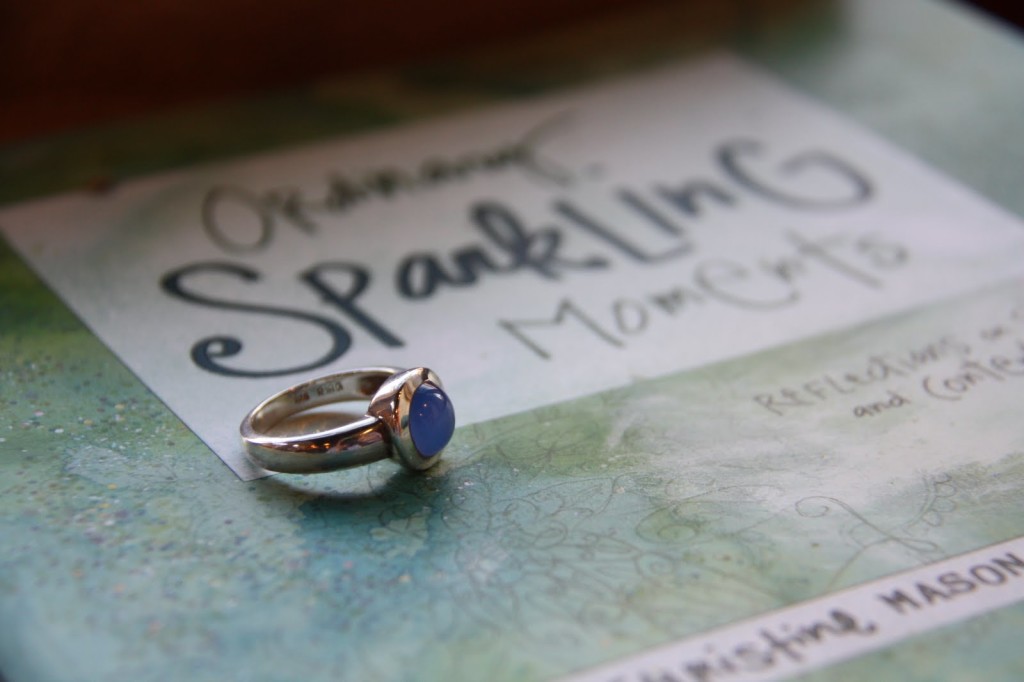
Three and a half years ago, I brought myself a promise ring.
I was visiting Banff at the time, after a business-related road trip through Western Canada. Visiting Banff always brings up mixed emotions for me. I love the beauty of the place, in the middle of the Rocky Mountains, but it holds a sad story from my past. I lived there the summer I turned 19, and it wasn’t a particularly happy summer. I was in that “trying to decide whether to stay safe in life or to take more chances and risk getting hurt” phase of early adulthood. Sadly, I let the things that happened to me that summer convince me that safe was a better option. I gave up the plans I’d had to change schools and move to another province and I went back home to nurse my wounds and play it safe.
One of the places that always brings up deep longing for me is the Banff Centre. When I lived there, my roommates and I sometimes went to watch visiting performers, and each time I went, I’d think “oh, if only I were talented enough to spend time at a place like this!”
When I visited three and a half years ago, I drove past the Centre and started to cry. I cried for the young woman I was more than twenty years earlier who believed she wasn’t talented or worthy. I cried for the hurts that young woman had already suffered and had yet to suffer. I cried for the long journey I’ve had since then, learning to trust both my worthiness and my longings, and learning to be both resilient and courageous through the hard times.
When I drove back into town after visiting the Centre and the resort where I spent the summer cleaning other people’s mess out of hotel rooms, I wandered through the downtown and dropped in at a jewellery store. In a flash of inspiration, I bought myself a promise ring with a blue chalcedony stone. (I later learned that the chalcedony speaks of spirit and trust and is known as the Speaker’s Stone, the stone of one who must measure his words. It encourages reflection and meditation, its gentle radiance preparing us for action but helping to hold back words we might regret. The great Roman orator, Cicero, is said to have worn one around his neck.)
Later that day, I sat in a cafe with my journal and wrote the following promise to myself:
I promise:
– I will take more chances.
– I will believe that I am an artist.
– I will trust my ability.
– I will look for opportunities to paint and make art as often as I can.
– I will sign up for another class or workshop that stretches me.
– I will honour the muse.
I couldn’t go back and make those promises for my 19 year old self, but it wasn’t too late to make them for my 40+ self.
Last week, in the last lesson for Lead with Your Wild Heart, I invited participants to make a commitment to themselves and to honour it with some kind of gift, like a ring. That tweaked my memory and I went back to find the original post I wrote about the promise ring I’d bought for myself. I started crying all over again – not because I was sad anymore for my 19 year old self, but because I am delighted for my 46 year old self that I can honestly say that I have kept my promise to myself.
I have done just what I said I’d do. I took more chances (quit my job and started a business), started making more art and taking art classes, I’ve been honouring the muse, and trusting my own ability.
Nothing to date has felt so much like an honouring of that promise as the creation of Lead with Your Wild Heart. Nothing has felt so much like it is emerging out of my most authentic, most beautiful, most Spirit-guided self.
I’ve just opened registration for the second offering of Lead with Your Wild Heart, and I can say that I am thrilled beyond expectation with how beautifully it has turned out. This has been an exercise in trusting my own wild heart, and I know that it will serve as a gift to all those who take it into their own wild hearts.
And now… can I tell you a little secret? I’m dreaming of taking some version of Lead with Your Wild Heart to the Banff Centre for Leadership Development. I don’t know yet how to make that happen, but I’m sharing the dream in hopes that will help me get closer to it.
I’m trusting my wild heart and seeing where it leads.
by Heather Plett | Jan 17, 2013 | Beauty, grace, grief, growth, journey, Uncategorized
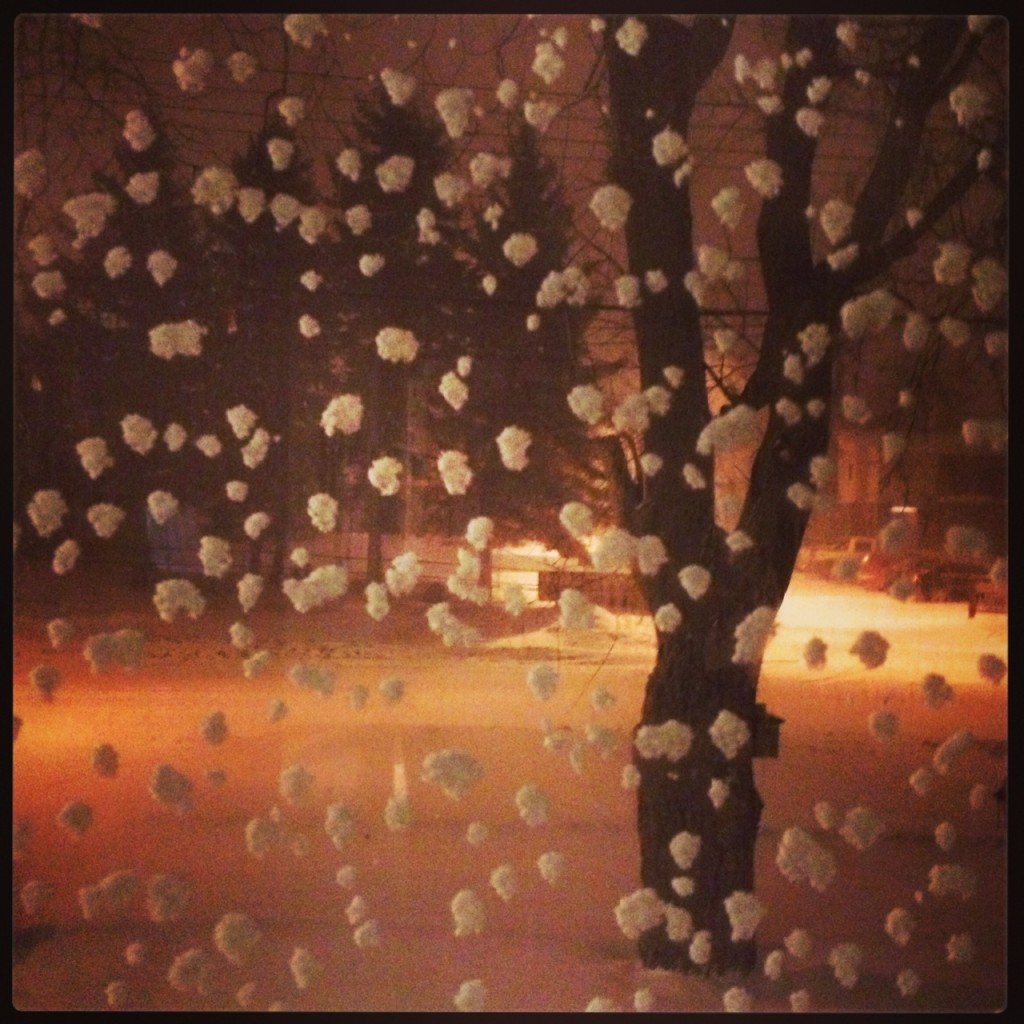
This much I can tell you – hard times are going to come your way. Grief, pain, anger, disappointment, hurt, tears – you’ll face them all in this lifetime.
I wish I could promise you otherwise, but my life story bears the truth of what I’ve just said. You will face the death of people you love, you will find yourself lost in the abyss, you will be betrayed by those closest to you, and you will go through periods of devastating self-doubt.
Last night I had a powerful dream that the whole world was falling apart. It was probably a reflection of the many conversations I’ve had with people recently who’ve felt like their worlds were falling apart. In the dream, there was a major catastrophe (something like an earthquake) and there was calamity all over the world. I spent most of the dream trying to find and rescue people who were lost in the damaged world. It wasn’t a stressful act – it was just something that needed to be done.
I know what the dream means. This is my work in the world – helping people navigate their way through broken places in their lives; helping them see the light when they’re lost in the dark. Quite significantly, in the dream I was doing it with the help of my Mom and Dad. Both Mom and Dad have been my torchbearers, and even after their deaths, they continue to help me in this work.
I’ve gotten mad at God sometimes, for not giving me a calling in which I could invite people onto an easy path. Instead, I got the calling to help people navigate in the dark. It’s hard to market the dark path – it just doesn’t sell the same way “ten easy steps” does. Once I finally surrendered to it, though, I realized that my calling is much deeper and more beautiful than the easy one I longed for. This is a good life, despite the pain – and maybe even because of the pain. Light is so much more stunning when you know what darkness looks like.
Here’s what I’ve learned about navigating in the dark:
- You can survive more than you think you can. You’ll hit what you’re sure is rock bottom, and you’ll think “I can’t possibly live through one more hardship”, and then rock bottom will be taken away from you and you’ll be falling again, to a new bottom. You can survive it. Trust the Source of your strength, the God of your understanding, and the strength you need will show up.
- You can fall apart, but that doesn’t mean you’ll be permanently broken. In the cycle of life, deconstruction has to happen before construction can begin. The falling apart is necessary – let it happen. Don’t try too hard to hold yourself together. Old patterns need to die (painful but true) before new patterns can emerge. Think of the seed that needs to crack open for a tree to grow. Yes, it’s painful for that seed, but if it doesn’t crack open, it withholds life.
- Your greatest enemy is the shame of what you’re trying to hide from the world. Shame will cause you to do unhealthy things just to maintain your reputation as a “pulled-together” person. Let go of your image of a pulled-together person and practice letting go of the shame. I say “practice”, because it takes time, effort, and some pretty deep personal work to recognize the shame and gradually let it go. (See Brene Brown’s work or Cath Duncan’s work for more on shame resilience.)
- Let go of any illusion you have that you are in control of what happens. There are many in the self-help world who will tell you that your thoughts attract what comes to you in your life, but if you believe that when hard times come your way, you will be side-swiped by self-hatred in the middle of your grief. You didn’t bring this on. The best you can do is live through it with some measure of grace. And if you don’t always feel full of grace, forgive yourself for that. Let the grace come from some other Source than you.
- As any white-water rafter will tell you, your safest bet is to surrender to the waves and stay vigilant for the rocks and whirlpools. Let the grief happen. Ride it out and do what you can to guide your boat between the rocks, but don’t try to resist it. You can’t stop the river, so you might as well ride with it and trust that it will eventually take you to a place of calm. Embrace the word “surrender”.
- Search for the points of light. Pay attention to those moments when the sunset is particularly stunning, your friend shows up at just the right moment, a breeze kisses your cheek, you’re drawn to a blog post that was just what you needed to read right now, or someone offers to take over a task that’s become too difficult for you. Each point of light is God shining through the darkness. Those tiny points of light will guide you through the darkness until you see the dawn again.
- Trust that this hardship is a deepening of your spiritual journey. Everyone wants an easy path to enlightenment, but nobody gets it. As Caroline Myss reminds us in Sacred Contracts, all of the leaders of the world’s major religions – Jesus, Muhammed, and the Buddha – had to go through times of testing before they could be commissioned into their roles as teachers. Your hardships will deepen your work and take you further into your calling. This I know from personal experience. I would not be doing the work I’m doing today if I hadn’t gone through the loss of my son.
- Reach for other people in the dark. There are people who want to walk with you through this dark place. There are people who can help you see the light. It’s okay to reach for them. You don’t need to do this alone. Darkness is easier to navigate if you find someone holding a flashlight.
- Life won’t always be this hard. When you’re down there at rock bottom and you haven’t seen a pinpoint of light for weeks, you’re going to become convinced that this is all there is to life and you’ll never be free of the pain. I’m not going to tell you that it’s easy or that you have to have faith. (Read Ronna Detrick’s excellent post about faith in the darkness.) I’m simply going to tell you that there will be light again. And the light will have a deeper, richer shine to it than anything you’ve ever seen before.
 I always feel a mix of emotions at this time of year.
I always feel a mix of emotions at this time of year.






